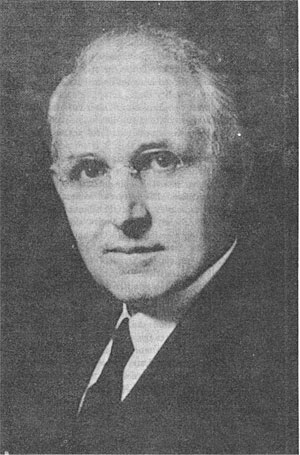Charles A. Kraus
Charles August Kraus ( * August 15, 1875 in Knightsville, Indiana, † June 27, 1967 in Providence, Rhode Iceland ) was an American chemist.
He was the son of German immigrants. His father had been a winery in Traubach before he emigrated to the USA in 1857, farmers near Knightsville was. Kraus attended high school in Hayes City and began to study electrical engineering in 1893 from the University of Kansas, but soon turned to physics and physical chemistry. In 1898, he earned his bachelor 's degree and could already boast a number of publications. He spent a year at Johns Hopkins University, in Kansas and later at the University of California. In 1904 he went as a research assistant to Arthur Amos Noyes ( 1866-1936 ) to the Massachusetts Institute of Technology, where he received his doctorate in 1908 and 1912 was assistant professor.
In 1914 he became a professor and director of the chemical laboratory of Clark University. In 1924 he became professor of chemistry and director of the chemical laboratories of Brown University, where he remained until his retirement in 1946. Even after that he remained scientifically active.
In 1937 he held the Gibbs Lecture. In 1923 he received the Nichols Medal, 1938, the Franklin Medal, 1935, the Willard Gibbs Medal, Theodore William Richards Medal 1936 and 1950, the Priestley Medal. He was a member of the National Academy of Sciences (1925 ), the American Association for the Advancement of Science and the American Academy of Arts and Sciences, and in 1939 president of the American Chemical Society. For work during the Second World War in 1948 he received the highest civilian award of the U.S. Navy, the Naval Distinguished Public Service Award. He was more honorary doctorates ( Brown University, Clark University, Kalamazoo College, Colgate University, Indiana University).
Kraus dealt with many areas of chemistry with particular regard to the physico- chemical properties of liquid ammonia ( as a solvent of the electrolyte ), and generally with the properties (especially the conductivity) of electrolytic solutions with other solvents than water. Another focus was the chemistry of metal - organic compounds ( silicon, germanium, tin, boron, aluminum, gallium ). He developed a method, germanium and gallium from their ores to win.
He was married and had three sons and a daughter.
Writings
- The properties of Electrically Conducting system, American Chemical Society Monograph 1922










